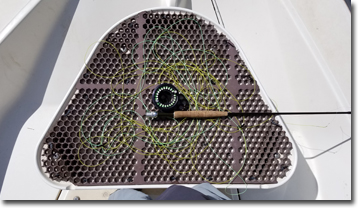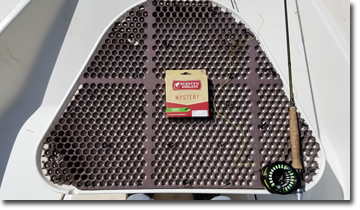Scientific Anglers Mastery Trout Fly Line
This fly line review relates to casting a floating line at distances over 30'. To be honest, I don't see the purpose of reviewing a floating fly line made for short range casting when most will do fine, in fact, a double taper is your best financial and efficient option. The last 5 or so years I have seen a manufacturer design change in weight forward tapers by extending the belly and/or increasing the weight 1/2 size to keep up with the rod manufacturers propensity to design faster rods. Ironically, the manufacturers design these long belly lines to sell them as "mend-friendly". The reason, I believe, is to assist in mending a strike indicator and obtain a longer float. I find this comical since I have personally witnessed this evolution and, not just with the younger crowd, but with all generations. It seems it no longer matters how you catch your fish but how many. The guides are there to show you how many in mere minutes and the fly line manufacturers are doing their best to equip you.
 The ironic part in all this is these long belly lines have been around for many years under the guise of specialty distance lines. Many years ago, when Bruce Richards worked for Scientific Anglers, he designed a fly line for the tournament casting scene. It was called the Expert Distance Line. It was designed under the premise of an extended belly. Weight forward fly lines are designed with a front taper, 2 bellies, and a rear taper. Extending the bellies serves a multi-purpose. It provides a longer mend, you can pick up a longer line to minimize false casts, and it assists in aerializing the line creating more distance. I have used the Expert Distance line for many years for dry fly lake fishing. Nowadays, the marketing is different but the extended, or long belly still exists but you have to look at the specs and check out the taper because it may be marketed for the bobbering crowd. Scientific Anglers no longer sells the Extended Distance in a 4 weight, it is sold in 5 and heavier weight. The good news is their latest iteration in the Mastery Trout series is the same taper as the Extended Distance line. Another SA line with the same taper is in their Mastery Textured Trout Series, however, I believe it wasn't a big seller because they labeled it as "a Dry Fly Line". The bobber crowd avoided that like a Zika virus. If it was labeled as "perfect with Strike Indicators", it might have been a huge success.
The ironic part in all this is these long belly lines have been around for many years under the guise of specialty distance lines. Many years ago, when Bruce Richards worked for Scientific Anglers, he designed a fly line for the tournament casting scene. It was called the Expert Distance Line. It was designed under the premise of an extended belly. Weight forward fly lines are designed with a front taper, 2 bellies, and a rear taper. Extending the bellies serves a multi-purpose. It provides a longer mend, you can pick up a longer line to minimize false casts, and it assists in aerializing the line creating more distance. I have used the Expert Distance line for many years for dry fly lake fishing. Nowadays, the marketing is different but the extended, or long belly still exists but you have to look at the specs and check out the taper because it may be marketed for the bobbering crowd. Scientific Anglers no longer sells the Extended Distance in a 4 weight, it is sold in 5 and heavier weight. The good news is their latest iteration in the Mastery Trout series is the same taper as the Extended Distance line. Another SA line with the same taper is in their Mastery Textured Trout Series, however, I believe it wasn't a big seller because they labeled it as "a Dry Fly Line". The bobber crowd avoided that like a Zika virus. If it was labeled as "perfect with Strike Indicators", it might have been a huge success.
Why all the fuss with fly lines? Again it doesn't matter if all you intend to do is bob a strike indicator 40' away. In fact, there is absolutely no skill required. Selecting a proper fly line for river fishing is a simple process... buy the cheapest one or buy the most expensive, just because. Next to a fly rods action, I consider a proper fly line the most important component of your fly fishing equipment.
After witnessing from above and below what a fly line and leader does to feeding fish, I only use a 4 wt. The logic is simple. Cast a 6wt line near feeding fish in calm waters and watch the response. Chances are the water spray alone will alert the fish before the line and fly ever touches the water. A 5 wt has less spray, a 4 wt even less. Pick up a 6 wt from a 50’ cast and watch the violent water disturbance. Look closely at the landing of a 6 wt line. There's nothing subtle about it. This is all well and good if you’re fishing salmonflies, hoppers or floating a western river, however, for my preference, it’s all about stealth. This is not to say you can’t use a 6 wt and catch rising fish in still waters, I did it for years when I was first learning the sport. It didn't take long to realize it was detrimental to what I was trying to accomplish which was stalk fish without being spotted first.
 The fly line I prefer is a Scientific Anglers Mastery Expert Distance 4wt. Since they stopped manufacturing them in a 4wt in 2016, I switched to the Mastery Trout 4wt. It is exactly the same taper. Why is this important? Most weight forward fly lines have a total head length around 35' to 45'. With proper technique, they will cast long but you will sacrifice accuracy. Standard weight forward lines will only aerialize the length of their head so your only option is to "shoot" the head toward your target. This is fine if you're fishing Pyramid Lake with a sinking line but it my case, and the purpose of this review, I'm casting to moving targets at variable distances. The Mastery Trout total head length is 66’. Again, this allows you to minimize false casts, aerialize a longer cast and pick up a longer line. Very few lines on the market will do this. A double taper line comes close, however, they tend to be too heavy for the distance cast so you’re forced to underline to give the smooth feel that you're comfortable with.
The fly line I prefer is a Scientific Anglers Mastery Expert Distance 4wt. Since they stopped manufacturing them in a 4wt in 2016, I switched to the Mastery Trout 4wt. It is exactly the same taper. Why is this important? Most weight forward fly lines have a total head length around 35' to 45'. With proper technique, they will cast long but you will sacrifice accuracy. Standard weight forward lines will only aerialize the length of their head so your only option is to "shoot" the head toward your target. This is fine if you're fishing Pyramid Lake with a sinking line but it my case, and the purpose of this review, I'm casting to moving targets at variable distances. The Mastery Trout total head length is 66’. Again, this allows you to minimize false casts, aerialize a longer cast and pick up a longer line. Very few lines on the market will do this. A double taper line comes close, however, they tend to be too heavy for the distance cast so you’re forced to underline to give the smooth feel that you're comfortable with.
My Scientific Mastery Trout 4 wt, with it's 67' head length also has a built color identification that extends 40' into the 2nd belly section of the fly line. On Scientific Anglers website, it is unclear what this even means. It is probably intended as a line indicator for mending, however, I have found the most useful purpose for this is a line indicator to know exactly how much line to pick up to minimize your false cast. It's brilliantly useful for anglers that do not double haul or don't cast that often to even know how many lines to pick up to load their rod. One other note, for those anglers trying to save a buck on eBay (aren't we all), the previous version of the SA Mastery Trout is not the same as latest release. The previous Trout series came with the standard 35' head length. How do I know? I fished it for a day, swearing up a storm wondering why I couldn't cast past 70' until I measured the head length. Hey, I was just trying to save a buck.
